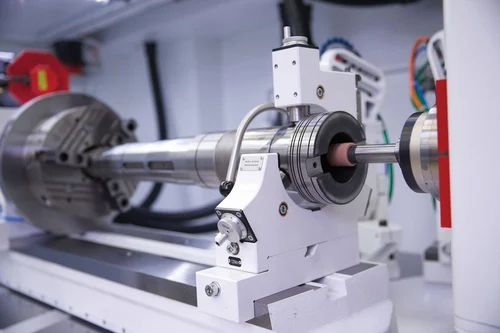In the modern manufacturing industry, precision and efficiency are key to producing high-quality components. One machine that excels in delivering both is the CNC internal grinding machine. Used extensively in industries such as automotive, aerospace, and engineering, this type of grinder is essential for producing parts with tight tolerances and intricate internal shapes. But how exactly does a CNC internal grinding machine work, and what makes it so vital in today’s production processes?
In this blog post, we’ll delve into the inner workings of a CNC internal grinding machine, its key components, and how it contributes to high-precision manufacturing.
What is a CNC Internal Grinding Machine?
Before understanding how it works, let’s define what a CNC internal grinding machine is. As the name suggests, this machine is used to grind the internal surfaces of cylindrical components. These machines are equipped with computer numerical control (CNC), which automates the grinding process and ensures precision, consistency, and speed.
CNC internal grinding machines are commonly used to finish internal bores, holes, and cylindrical shapes in a wide variety of parts. They are designed to achieve tight tolerances that would be difficult or impossible to accomplish with manual grinding techniques. The CNC system allows operators to program precise movements and grinding parameters, enabling the machine to produce components with exceptional accuracy.
Key Components of a CNC Internal Grinding Machine
To fully understand how a CNC internal grinding machine operates, it’s essential to first explore its key components. These parts work in tandem to carry out the grinding process smoothly and efficiently:
1. Workpiece Headstock
The headstock holds the workpiece securely in place during the grinding operation. Depending on the machine model, it can rotate the workpiece or keep it stationary. The headstock allows for precise alignment, ensuring that the grinding operation is carried out at the correct angle and position.
2. Grinding Wheel
The grinding wheel is the heart of the machine. This abrasive tool is responsible for removing material from the internal surfaces of the workpiece. The type, size, and material of the grinding wheel can vary based on the specific requirements of the job, but it is usually made from materials like aluminum oxide or silicon carbide to provide optimal hardness and cutting ability.
3. Wheel Head
The wheel head houses the grinding wheel and controls its movement. CNC programming determines the exact movements and speeds of the wheel head, enabling it to make precise adjustments and apply the appropriate pressure during grinding.
4. Control System (CNC)
The CNC control system is the brain of the machine. It processes the input commands given by the operator and translates them into precise movements. The CNC system allows operators to program complex grinding cycles, control the position and speed of the grinding wheel, and monitor the entire grinding process in real time. The system ensures that every part is machined with the same level of precision.
5. Spindle
The spindle drives the grinding wheel, enabling it to rotate at high speeds. The spindle speed can be adjusted based on the material and the level of precision required. Faster speeds are typically used for rough grinding, while slower speeds are applied during finishing operations.
6. Tailstock
The tailstock supports the workpiece at the opposite end of the headstock. It helps maintain stability, especially for longer or more delicate parts, ensuring that the workpiece does not shift or vibrate during grinding.
7. Cooling System
Grinding generates heat due to friction between the grinding wheel and the workpiece. To prevent overheating and material deformation, CNC internal grinding machines are equipped with a cooling system. The coolant helps dissipate heat, ensuring a smooth grinding process and prolonging the life of both the grinding wheel and the workpiece.
How Does a CNC Internal Grinding Machine Work?
Now that we’ve explored the key components of a CNC internal grinding machine, let’s break down the step-by-step process of how it operates:
1. Workpiece Setup
The process begins with securing the workpiece in the headstock and tailstock. The operator ensures that the workpiece is correctly aligned and properly positioned for grinding. Once secured, the CNC system is programmed with the necessary parameters, such as the size, shape, and depth of the internal surface to be ground.
2. CNC Programming
CNC programming is a critical step in the grinding process. The operator uses the CNC control system to input the required grinding cycle, including the speed of the spindle, the feed rate of the grinding wheel, and the desired level of precision. Advanced CNC systems allow for detailed and complex programming, ensuring that even intricate internal geometries can be achieved with precision.
3. Grinding Wheel Engagement
Once the program is loaded, the grinding process begins. The grinding wheel, driven by the spindle, moves toward the internal surface of the workpiece. Depending on the task, the wheel can either make rough passes to remove large amounts of material or execute finer passes to achieve the required surface finish.
4. Material Removal
As the grinding wheel rotates, it gradually removes material from the internal surface of the workpiece. The CNC system ensures that the grinding wheel follows the programmed path, maintaining the correct distance and pressure between the wheel and the workpiece at all times. This level of control allows the machine to achieve consistent and repeatable results, even for large production runs.
5. Cooling and Monitoring
Throughout the grinding process, the cooling system is engaged to manage heat buildup. The CNC system continuously monitors the grinding operation, making real-time adjustments to ensure that the grinding wheel remains sharp, the workpiece stays cool, and the desired dimensions are achieved.
6. Finishing and Quality Control
Once the grinding operation is complete, the workpiece is inspected to verify that the internal surfaces meet the required specifications. CNC internal grinding machines are capable of producing extremely smooth and precise finishes, making them ideal for components that demand high-quality surfaces. If necessary, the machine can make further passes to refine the finish or correct any minor deviations.
Advantages of CNC Internal Grinding Machines
The benefits of using a CNC internal grinding machine are numerous, especially for industries that require precision components. Here are some key advantages:
1. High Precision
CNC technology ensures that the machine delivers exceptional precision, consistently producing parts that meet tight tolerances.
2. Automation
The CNC system allows for automated grinding cycles, reducing the need for manual intervention and freeing up operators to focus on other tasks.
3. Versatility
CNC internal grinding machines can handle a wide range of materials and shapes, making them suitable for various applications in different industries.
4. Consistency
The repeatable nature of CNC programming ensures that every part produced is identical, regardless of batch size.
5. Efficiency
By automating the grinding process, CNC machines improve efficiency and reduce production time, leading to higher output.
Conclusion
A CNC internal grinding machine is an indispensable tool for modern manufacturing, offering a perfect blend of precision, automation, and versatility. By understanding how these machines work and their key components, manufacturers can maximize their efficiency, enhance product quality, and stay competitive in demanding industries.



